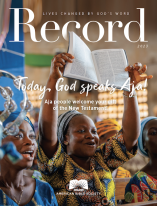How Does God Speak Through Scripture?
Reviewing a New Book on an Ancient Practice
For the past several months, my small group Bible study has been using a variation of lectio divina, the classic spiritual practice of hearing God speak through Scripture. It has worked well for us. One benefit of the method is that it requires no preparation or homework, but can linger with you over the week, opening up an ongoing conversation with God.
This is one of the reasons I was excited to encounter Meeting God in Scripture: A Hands-On Guide to Lectio Divina (InterVarsity), a new book from Jan Johnson, which offers a clearly written and inviting introduction to the lectio method. (I co-hosted a conference a few years back featuring the author, so I’ve long admired her teaching style and appreciated her depth. Some readers may also recognize Johnson for her work over the years with the late Dallas Willard.)
Training Wheels
This book is the fruit of more than two decades of experience in leading individuals and groups in scriptural meditation, and she maintains a refreshing tone of quiet confidence throughout. Presented as an attempt to “provide ‘training wheels’ to help people move into Scripture meditation,” the book offers far more. It includes a full forty guided exercises on different Scriptures (organized topically—like “What does God think of me?” and “Facing fears, frustrations, and discouragement”). Most of these are deeply insightful and several include perspectives I had not considered before. After a practical introduction to get the reader started, she turns immediately to the meditations, saving other helpful advice to be doled out over time across the pages (though trackable in the table of contents).
After completing one or two exercises, we are reminded anew of the value of silence. Indeed, this approach could be just the ticket for hurried people or those in danger of burnout from other types of Bible study. The questions in each exercise are certainly designed to help corral the thoughts of easily distracted people like me: “People seem to focus better when I ask them questions to guide them through the process of meditation,” writes Johnson. And while the approach is not opposed to study and deep Scripture knowledge, she is clear that our focus here is not on intellectual satisfaction: “Scripture meditation is another way to become more attentive to the still, small voice of God and to become more willing to respond when we hear it.”
The 4 Stages, Plus 2
For each passage, she follows the traditional four stages of the classic lectio divina approach—read, reflect, respond, rest. She bookends these with two more optional stages—”relax and refocus” to help readers prepare for the exercise, and “trying it on” to help readers put into action what God tells them. The book includes the full text of each passage (usually in the NIV translation) along with some helpful footnotes so that the reader does not need to stop and look up context and terms.
The meditations are designed for individual use, but she includes directions to use the book in a small group setting. The reminders of how a lectio group differs from a traditional discussion group are telling: During the “reflect” stage, for example, we are concerned less with analysis and more with trying to listen to God speaking in Scripture. A group leader needs to trust that God’s Spirit will speak to each person at their own level of comprehension—even children.
The Community of the Spoken To
This practice of listening can be difficult, as I also hear from pastors who participate in listening groups for our trauma healing program. The temptation to preach or try to “fix” the problem can be severe. Johnson reminds us that God speaks to us—that, in the words of Dallas Willard, “We stand within a community of the spoken to.” In the Scriptures, Christians affirm that God addresses us, even by name. The point here is to listen, and allow the others to listen, so that we can interact with our creator and be formed into the image of Christ.
For narrative Scripture passages, Johnson’s questions follow an Ignatian approach that helps readers place themselves imaginatively within the story, pondering the textures, smells, sounds and so on. Her method is essentially the same as the approach offered by American Bible Society’s Catholic Initiatives department, though more focused for individuals and small groups. The forty specific passages that she treats are very well done, and are likely to provide fresh perspectives even for those familiar with the lectio approach.
Reading through Meeting God in Scripture left me thinking: if this is what God can do with training wheels, how much more is there to find as we catch our balance and get up to speed.

Peter Edman
Peter Edman is director of content and quality assurance for American Bible Society and executive editor of the Faith and Liberty Bible. He holds a master’s degree in religion and literature from Yale Divinity School. He and his family live in Philadelphia.
Thanks to the support of our faithful financial partners, American Bible Society has been engaging people with the life-changing message of God’s Word for more than 200 years.
Help us share God's Word where needed most.
Connect with our Bible engagement blog for leaders and receive a Bible-reading Habit Guide for your community.









